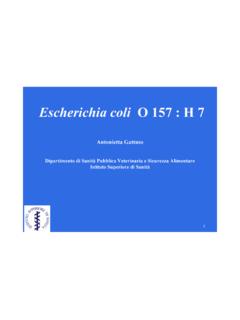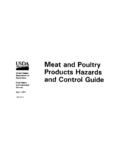Transcription of PATHOGENS: SYMPTOMS, TIMES OF ONSET, …
1 pathogens : SYMPTOMS, TIMES OF ONSET, DURATION. Pathogen Symptoms time of onset / Incubation Duration Bacillus cereus (emetic) Nausea, vomiting, occasional diarrhea (1901) 1/2 to 5 hours (1901) Usually 6 to 24 hours (1901). Nausea, vomiting, occasionally followed by diarrhea (NZ) 1 to 6 hours (NZ) 12 to 24 hours (NZ). Nausea, vomiting; occasionally, abdominal cramps and/or 1/2 to 6 hours (BB) Less than 24 hours (BB). diarrhea (BB). Acute attach of vomiting; generally no diarrhea, but can occur 1 to 6 hours (mean 3 hours 6 to 24 hours (M&B). [table says 1 to 5 hours]. (M&B). Bacillus cereus (diarrheal) Nausea, abdominal pain, watery diarrhea (Mild, self-limiting) 8 to 16 hours (mean 12 hours) Usually 6 to 24 hours (1901). (1901) (1901). Abdominal pain, watery diarrhea, occasional nausea (NZ) 10 to 12 hours (NZ) 12 to 24 hours (NZ). Watery diarrhea, abdominal cramps, pan; nausea may accompany 6 to 15 hours (BB) Symptoms persist 24 hours diarrhea; vomiting rarely occurs (BB) (BB).)
2 Nausea (rare vomiting), abdominal distress, rectal tenesmus, 8 to 19 hours (M&B) 12 to 24 hours [table says 12 to watery stools; generally no fever (M&B) 14 hours] (M&B). Campylobacter C. jejuni: Diarrhea (often TIMES bloody), severe abdominal pain, 2 to 7 days (mean 3 to 5 days) 1 to 4 days; no longer than 10. fever, loss of appetite, general feeling of ill health, headache, (1901) days (1901). vomiting (Mild to moderate) (1901). Campylobacter: Muscle pain, headache, fever, followed by 1 to 10 days (usually between 2 1 day to 1 week or longer watery / bloody diarrhea, abdominal pain, and nausea (NZ) and 5 days (NZ) (usually 5 days) (NZ). C. jejuni: Watery, sticky, and maybe bloody diarrhea; often 2 to 5 days (BB) 7 to 10 days, with 25% relapse fever, abdominal pain, nausea, headache, muscle pain (BB) rate (BB). Campylobacter: Cramping abdominal pain, diarrhea; fever, Campylobacter: 1 to 7 days Campylobacter: 2 to 6 days chills, headache, myalgia, occasional delirium; nausea; (average 3 days) (M&B) (M&B).)
3 Vomiting rare; up to 25% asymptomatic (M&B). Clostridium botulinum Nausea, vomiting followed by neurological systems (problems 12 to 36 hours, sometimes 8% fatality rate; 80%. with vision, fatigues, lack of coordination, throat and mouth several days (infant bot 3 to hospitalization and intensive problems (infant bot constipation followed by lethargy, 30 days) (NZ) therapy (infant bot 5% of all inability to feed properly, floppiness respiratory arrests (NZ) SIDS cases in USA, Europe). (NZ). Marked lassitude, weakness and vertigo, usually followed by 18 to 36 hours (can be 4 hours A life-threatening disease; high double vision, progressive difficulty speaking and swallowing; to 8 days) (BB) mortality rate if untreated also possible difficulty in breathing, weakness of other (BB). muscles, abdominal distention, constipation (infant bot constipation following normal development, followed by poor feeding, lethargy, weakness, pooled oral secretions, wail or altered cry, loss of head control) (BB).))
4 Lh2&F:lynnmisc:MISC: :incub-table2005-foremail orig 7/19/05 rev 7/27/05 print 8/3/05 1. Pathogen Symptoms time of onset / Incubation Duration Mild-double vision, difficulty swallowing for a few days; severe- Recovery over weeks to months comatose; complete paralysis; fixed, dilated pupils for months; (M&B). >1/2-prodromal nausea or vomiting; first symptoms- lprogressive cranial nerve palsies ( , double vision, drooping eyelids, slurred, muted speech; inability to swallow; gaze paralysis, dialted pupils); weakness below neck respiratory distress; constipation, urinary retention, hypotension; fatigue (M&B). Clostridium difficile Watery diarrhea, fever, loss of appetite, nausea, abdominal pain /. tenderness; complications pseudomembranous colitis (PMC), toxic megacolon, perforations of colon, sepsis, death rare (CDC). Clostridium perfringens Abdominal pain, diarrhea; rarely vomiting or nausea; fatalities 8 to 22 hours (10 hours) (1901) 12 to 24 hours (1901).
5 Are rare (1901). Profuse watery diarrhea, severe abdominal pain that subsides 6 to 24 hours; usually 10 to 12 Within 24 hours (NZ). with 24 hours; vomiting, nausea rare (NZ) hours (NZ). Intense abdominal cramps and diarrhea (BB) 8 to 22 hours (BB) Within 24 hours, less severe symptoms may persist 1 to 2. weeks (BB). Type A-diarrhea, abdominal cramps Type A-8 to 16 hours Type A-12 to 24 hours (can be Type C(?)-necrotic enteritis (severe abdominal pain, bloody Type C-1 to 5 days (M&B) fatal in elderly) (M&B). diarrhea, vomiting, obstruction of intestinal mucosa); rare and more serious (M&B). Cryptosporidium parvum May be asymptomatic; frequently characterized by severe watery 1 to 2 weeks (1901) 4 days to 3 weeks (1901). diarrhea. Pulmonary or tracheal cryptosporidiosis is associated with coughing and low grade fever accompanied by severe intestinal distress (moderate to severe) (1901).
6 Watery diarrhea, vomiting, anorexia, malaise, cramping, weight 3 to 11 days (NZ) 2 to 4 days (NZ). loss (NZ). Severe watery diarrhea; may be asymptomatic; pulmonary /. tracheal cryptosporidiosis associated with coughing, low-grade fever, accompanied by severe intestinal distress (BB). Acute diarrhea (M&B) 3 to 7 days (M&B) Self-limiting (M&B). Enteric viruses: Rotaviruses, Rotaviruses: acute gastroenteritis; vomiting, watery diarrhea, Rotaviruses: 1 to 3 days (BB) Rotaviruses: vomiting first, Hepatitis E, Pocornaviruses, low-grade fever (mild to severe); temporary lactose intolerance then 4 to 8 days diarrhea Adenoviruses, Parvoviruses (BB) (BB). Hepatitis E: shares many characteristics of hepatitis A; mild Hepatitis E: about 6 weeks Hepatitis E: self-limiting (M&B) (M&B) (M&B). Escherichia coli O157:H7 Severe abdominal pain, watery diarrhea that may become grossly 3 to 7 days (1901) Days to weeks (1901).
7 Bloody; occasionally vomiting occurs; maybe fever; may lead to severe complications in young children, elderly and immune-compromised persons. 2 % fatality case ratio (moderate to severe) (1901). lh2&F:lynnmisc:MISC: :incub-table2005-foremail orig 7/19/05 rev 7/27/05 print 8/3/05 2. Pathogen Symptoms time of onset / Incubation Duration Ranges from asymptomatic to kidney disease and death; with 3 to 9 days (mean 4 days) (NZ) Days to weeks (1901). serious cases, bloody diarrhea followed by HUS; TTP in elderly (NZ). Severe cramping (abdominal pain), diarrhea (at first watery, then Average 8 days (BB). grossly bloody); occasionally, vomiting; low-grade or no fever; some only have watery diarrhea (BB). Severe bloody diarrhea, abdominal cramps; may cause only 5 to 10 days (M&B). diarrhea or no symptoms; little or no fever; can cause HUS, HC, and thrombotic thrombocytopenic purpura, and lead to death in young children and elderly (M&B).
8 Escherichia coli (enteropathogenic) Water or bloody diarrhea; seen in infants, young children of 3rd- 1 to 6 days (1901) Days to weeks (1901). (infection?) (EPEC) world countries; products verotoxin or shiga-like toxin (mild to moderate) (1901). Infantile diarrhea; Watery or bloody diarrhea (perhaps caused by In infants, prolonged, leading to a verotoxin, Shigella dysenteriae (BB) death (50% mortality in 3rd- world countries) (BB). Watery diarrhea with vomiting and fever; some cases, protracted chronic enteritis (M&B). Escherichia coli (enteroinvasive) Diarrhea or milk dysentery; may be blood or mucous in stools; 1 to 3 days (1901) Days to weeks (1901). (infection) (EIEC) sometimes mistaken for shigellosis (mild to moderate) (1901). Mild dysentery, often mistaken for disease caused by Shigella; 12 to 72 hours (BB) Self-limiting (BB). abdominal cramps, diarrhea, vomiting, fever, chills, general maliaise (BB).)
9 Similar to disease caused by Shigella; diarrhea initially acute and watery, with fever, abdominal cramps; may progress to colonic phase with bloody, mucoid stools (M&B). Escherichia coli (enterotoxigenic) Watery diarrhea, abdominal cramps, low-grade fever, nausea, 1 to 3 days (1901) Days to weeks (1901). (toxicoinfection) (ETEC) malaise (mild to moderate) (1901). Cholora-like illness; called gastroenteritis / travelers' diarrhea; Diarrhea within 24 with high Usually self-limiting (BB). watery diarrhea, abdominal cramps, low-grade fever, nausea, infective dose (BB). malaise (BB). Watery diarrhea associated with cramps and low-grade or no fever; diarrhea has a lot in common with cholera (M&B). Escherichia coli: non-O157 shiga toxin- USA information estimates these types cause disease at 1/2 the producing (STEC) rate as Escherichia coli O157:H7 (NZ).
10 Escherichia coli (enterohemorrhagic) Severe bloody diarrhea (hemorrhagic colitis), HUS, TTP;. (EHEC) sometimes only diarrhea (M&B). Escherichia coli (enteroaggregative) Acute, persistent, bloody diarrhea in children (M&B). (EAEC). Giardia lamblia Abdominal pain, mucoid diarrhea, fatty stools (mild to moderate) 5 to 25 days (1901) Weeks to years (1901). (1901). Diarrhea (BB) Within 1 week (BB) 1 to 2 weeks; chronic infections months to years (BB). lh2&F:lynnmisc:MISC: :incub-table2005-foremail orig 7/19/05 rev 7/27/05 print 8/3/05 3. Pathogen Symptoms time of onset / Incubation Duration Severe weight loss, malnutrition to no symptoms; diarrhea Approximately 1 week; as short Mean duration in some studies accompanied by nausea or vomiting, abdominal bloating and as 1 to 2 days to 2 weeks 11 days; average duration 6. flatulence; greasy, foul-smelling, frothy stools; fatigue; fever (M&B) to 10 weeks without in 20% (M&B) treatment; can wax and wane, lasting from months to years (M&B).




